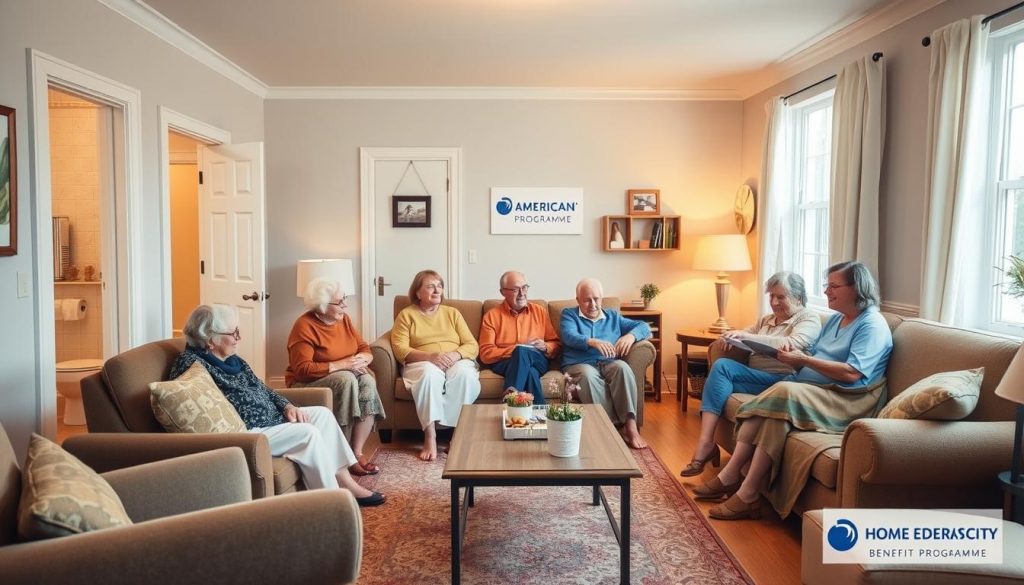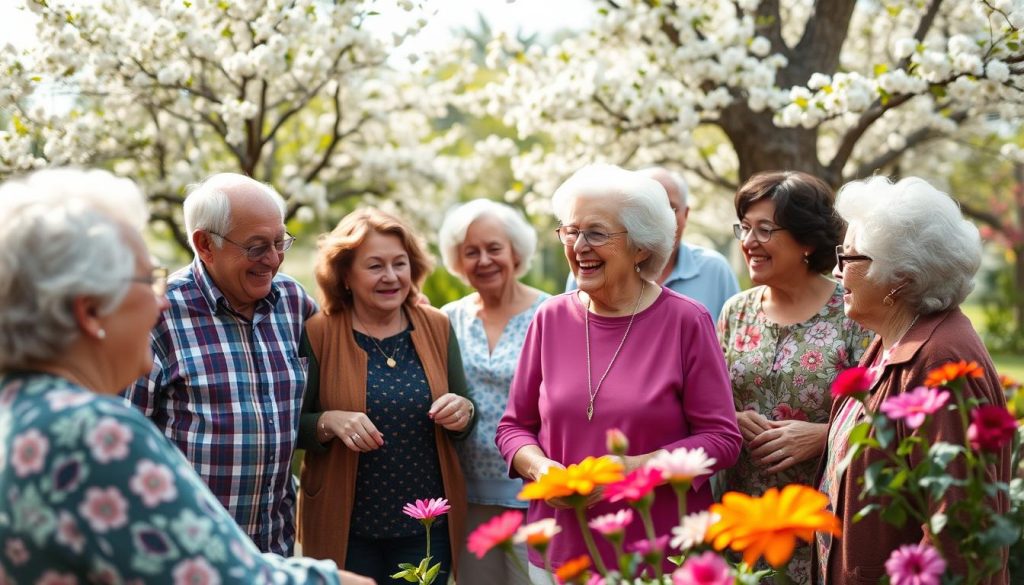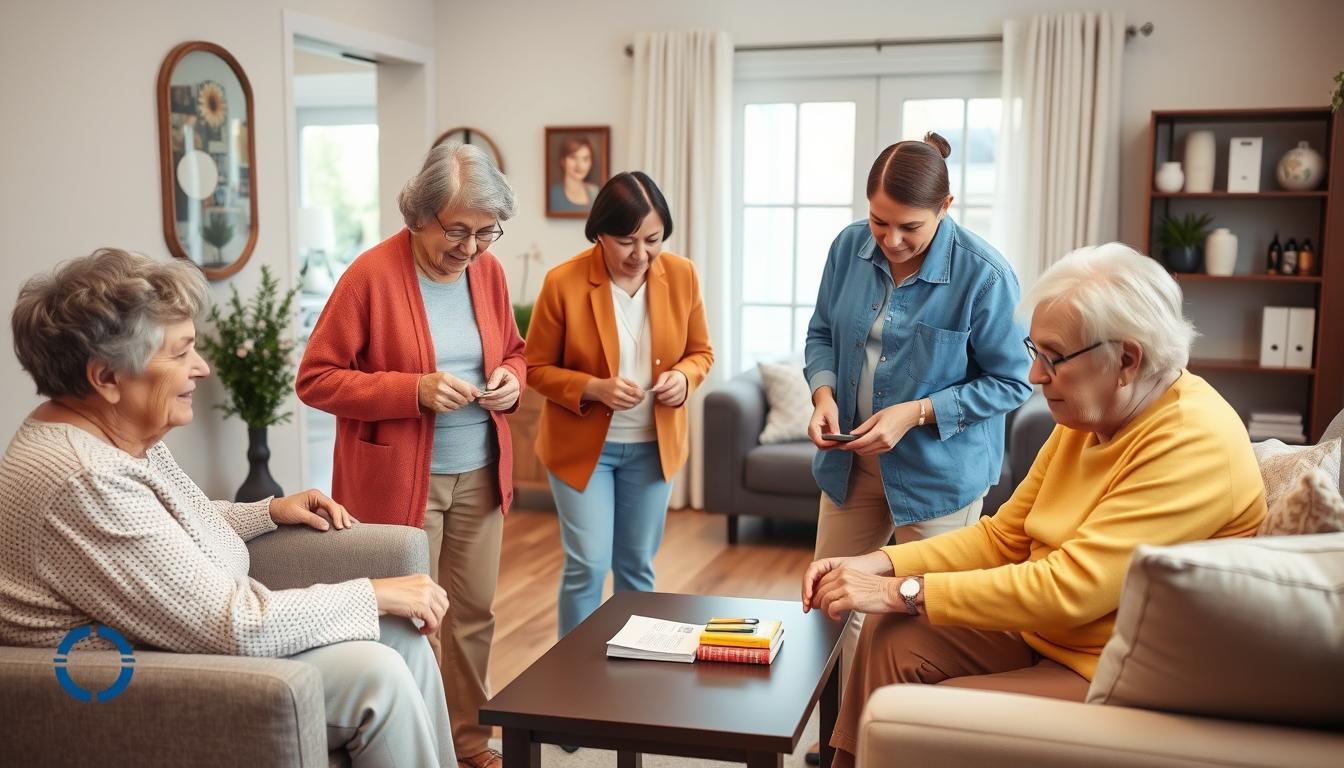Have you ever thought about how many seniors get hurt in their homes? Did you know that 1 in 4 older adults falls each year1? It’s very important to know about elder home safety. This guide gives tips and resources to keep seniors safe at home. We talk about how to plan and watch out for dangers. Families and caregivers will learn how to protect older adults living at home.
Simple changes can make a big difference in keeping seniors safe. Installing grab bars, using non-slip floors, and smart home tech can lower risks. With these tips, seniors can stay independent and safe. This article will show you how to make homes safer for our loved older ones.
Key Takeaways
- Knowing about high fall risks in seniors helps make homes safer.
- Putting in grab bars and non-slip floors prevents many accidents.
- Tech like medical alert systems boosts safety and readiness for emergencies.
- Getting regular health checks is key to spotting risks that could cause accidents.
- Community resources offer more help and info on keeping seniors safe at home.
Understanding the Importance of Elder Home Safety
Keeping a safe home is key as people get older. Falls, burns, and poisonings are top dangers for seniors living by themselves. This shows the need for a home safety checklist2. These accidents can be very bad. Falls are the biggest reason seniors get hurt, says the National Council on Aging3.
To stay safe, older folks should check their homes often. They should wear shoes that won’t slip and keep rugs taped down2. This can make a big difference in preventing trips and falls.
It’s important to have smoke alarms on every floor and near where you sleep. You also need carbon monoxide detectors near bedrooms and where there are appliances that burn fuel3. Teaching seniors about scams and how someone might try to take their money is key. Elder abuse isn’t just physical; it can be financial or emotional too3.
Making a home safe helps seniors live better and longer on their own. Taking steps to prevent accidents and changing things in the home for safety can give them peace. This is a big part of aging well.
Common Risks Faced by Seniors at Home
Seniors face many risks at home. Falls are very risky because they are tied to aging problems4. Floors can be tricky; carpets may trip you and hard floors can be slippery4. It’s key to check the home well to make it safer.
Being alone too much is also bad. It can make seniors feel lonely and lead to serious health problems5. If they live alone, getting help fast in emergencies is harder5. Also, taking many medicines can cause mistakes like taking too much by accident6.
Fires are another big risk. This is true in kitchens or with bad heating devices. It’s harder for many seniors to notice smoke or fires6. It’s really important to have smoke alarms that work, especially for changing batteries6. Having phones close and help from caregivers makes things much safer.
Knowing all these risks is important. We should work on ways to stop falls in homes. Making homes safer helps seniors live better lives.
Learn more about elder homesafety
Emergency Preparedness for Seniors
Seniors need to be ready for unexpected events. It’s important to prepare them and their caregivers. This way, they can deal with emergencies better.
Keeping Emergency Numbers Accessible
It’s key to have a list of emergency numbers close by. This includes 911, poison control, and family doctors. A NOAA Weather Radio is also good to have for weather alerts. The FEMA app is helpful for local emergency alerts78.
Creating an Emergency Action Plan
Having an emergency plan is crucial for seniors’ safety. They need to think about their health and the types of disasters that could happen. The plan should cover how to leave or stay safe at home7.
They should also keep medical and insurance papers handy. Building a support team of family and friends is smart. This team can help during an emergency and keep important items ready8.
Preventing Falls in the Home
Falls can hurt older adults a lot. It’s important to stop falls to keep homes safe. Making small changes can help a lot. These changes make homes safer for older people.
Implementing Safety Measures for Fall Prevention
To keep safe, adding handrails by stairs helps a lot9. They make it less likely for someone to fall. It’s good to have lights all over the house9. Lights make it easy to see where you’re going. Putting grab bars by the toilet and shower stops slips10. Also, getting rid of clutter and using mats that don’t slip makes a house safer11.
Creating a Non-Slip Environment
Making a place where you don’t slip is key. Put strips on the floor that stop slipping9. This is really good on shiny floors. Use night lights in the halls and bedrooms11. This helps you see at night. Keep things you use a lot in easy spots9. This way, you don’t have to reach far. Having a button to call for help if you fall is also comforting9. All these tips lower the risk of falling at home.
Essential Elder Home Safety Resources
Making homes safe for older adults is key. Safety checklists help spot dangers at home. They give caregivers a plan to find and fix risks.
Home Safety Checklists for Seniors
Checklists are key tools for elder safety. They let caregivers find dangers to keep seniors safe. A big 65% of homes with older adults have safety issues12.
It’s important for caregivers to make homes safer by:
- Putting grab bars in bathrooms to prevent falls.
- Making kitchens and hallways brighter.
- Changing bed heights and adding toilet seat risers.
- Keeping often-used items on the main floor to avoid falls.
These changes help create a safe space and lower accident risks.
Local Community Resources and Support Services
Community help is big for elder safety. Area Agencies on Aging offer specific help. Many seniors may fall this year; in fact, 1 in 3 could fall13.
Community groups can:
- Check homes for safety.
- Help seniors get mobility aids and safety gear.
- Run workshops on preventing falls and improving home safety.
Making homes comfy, safe, and fit for all ages is key to senior happiness.14
Home Modifications for Elderly Safety
Making changes at home is key for keeping older people safe and happy. As they get older, their needs for moving around, seeing, and thinking can change. Modifying their living space helps them live better and on their own. There are lots of programs that help with this, making safety a top thing to think about15. Making their homes safer is super important. It can stop falls and make getting around easier.
Installing Grab Bars and Handrails
Putting in grab bars and handrails is a great way to help elderly people stay safe. These help a lot when they need to use stairs or the bathroom, and stop falls. The CDC tells us it’s important to fix things that could cause falls15. Some groups help out if money is tight, showing how we can all help keep people safe16.
Ensuring Adequate Lighting and Accessibility
Good lights and easy-to-get-around spaces are super important for older folks. They need bright lights and clear paths to walk safely. About 90% of them want to stay in their homes as long as they can17. These changes make them feel more at home. Plus, they feel safer and happier.

Protecting Seniors at Home from Fire Hazards
Keeping seniors safe from fire is very important. This is because people over 65 face more dangers from fires. It’s key to install smoke alarms and plan how to escape fires at home.
Fire Safety Equipment Recommendations
To protect seniors, put smoke alarms on all floors. They need to work well. Many people can’t hear the smoke when asleep18. For those who can’t hear well, alarms with lights and vibrations help a lot19. Sprinklers in homes cut the risk of fire deaths by 80%19. They often stop fires in one room, which helps before firefighters get there19.
Creating a Fire Evacuation Plan
Seniors should practice getting out of their homes safely. They need at least two ways out. Practicing twice a year is good19. In a fire, move low if there’s smoke. Shut doors behind you. Don’t stop for things19. Using apps like Rescu means faster help during fires with just two taps18.
Medication Management for Senior Safety
Medicine management is key for seniors to stay healthy and safe. Older people often take many meds daily. This can lead to mix-ups and more chance of bad side effects. Over half of those aged 65 and up take four or more meds each day20. Also, seniors use 34% of all prescription meds in the U.S. but only make up 13% of the population21. It’s very important to handle meds carefully to avoid mistakes.
Organizing and Labeling Medications
Putting meds in clearly marked containers helps a lot. Many seniors forget things and can miss doses or take wrong amounts20. A system with colors or pill organizers makes it easier to remember their meds. Also, seniors usually use prescribed and non-prescribed meds, making things more tricky21.
Utilizing Technology for Medication Reminders
Tech can really help seniors manage their meds. Things like alarms, apps, and reminders keep meds on track. Many old people might not remember to take their meds because of side effects or doubts about if the meds work21. Using tech helps reduce mistakes and bad reactions, which are more likely in older people21.
Preventing Poisoning and Toxic Exposures
It’s really important to stop poisonings at home. This is because most happen right where we live22. Knowing what’s dangerous at home is the first way to keep safe. The places we need to watch are the kitchen, bathroom, and bedroom22.
Identifying Household Hazards
It’s key to know what can be harmful in our homes. Dangerous items include:
- Cleaning products
- Medications
- Cosmetics and personal care products
Lots of kids, especially infants to nine-year-olds, get poisoned by medicines23. Also, teenagers from ten to nineteen often get poisoned by accident too23.
Proper Storage Solutions for Cleaning Products
Making sure harmful products are stored safely can really help. Here are some tips:
- Keep dangerous items where kids can’t see or reach them.
- Make sure everything is labeled clearly.
- Keep medicines in their original boxes so instructions are easy to read.
Learning not to mix certain chemicals is also super important. Spending a little on Poison Control Centers can save a lot more in keeping everyone safe23.
Importance of Social Connections for Seniors
Having friends and family around is key for seniors. It makes them healthier and happier. Talking and spending time with loved ones can lessen sadness and loneliness24. These close bonds give support, companionship, and a big reason to enjoy life25. Staying in touch with people helps seniors feel less alone. It leads to a better and more joyful life26.
Engaging with Family and Friends
Staying close with family and friends is very important for seniors. Gatherings with family bring joy, and friendships fight loneliness. Studies show being social makes seniors more cheerful, smart, and heart-healthy24. These close connections help keep their minds sharp and spirits high. It lowers the chance of feeling down or forgetting things25.
Utilizing Community Resources for Socialization
Many places help seniors meet and make friends. Senior centers and groups have fun things to do, like classes and meals. These help seniors stay active and mentally sharp26. They make seniors feel welcome and part of a community. It helps them live happier and more connected lives24.

| Benefits of Social Connections for Seniors | Description |
|---|---|
| Improved Mental Health | Regular social interactions reduce risks of depression and anxiety. |
| Cognitive Health Maintenance | Social engagement helps maintain cognitive functions and reduces cognitive decline. |
| Enhanced Physical Well-Being | Connections lead to better physical health outcomes and promote healthy behaviors. |
| Sense of Belonging | Strong social networks provide emotional support and foster companionship. |
Ongoing Safety Assessments and Reassessments
Keeping homes safe for seniors is very important. We should check every part of their homes often. This includes the living room, stairs, bathrooms, kitchens, and outside. The goal is to avoid accidents and help seniors be more independent27. We look for things that could cause them to fall or get hurt27. We also check for fire risks and other dangers in each place27.
Creating a Routine for Safety Inspections
Having a regular check-up plan helps keep older adults safe. It’s good to check things often as needs can change28. To do this, we first talk to them, then closely look at what they need, and learn what they like and want29. By talking, we can make plans that make sure they stay safe and happy29.
Looking at homes can show us what needs to change. Perhaps we need to put in bars to grab or better lights27. It’s also good to see how caregivers are doing and what help they need28. Taking steps like these helps everyone stay safe and feel supported29.
Government Programs and Financial Resources
Seniors can have a better life with access to government resources. There are programs for home help, safety tools, and care services. The Older Americans Act (OAA) from 1965 helps seniors live on their own30. The government gives money for food help and rides for those 60 and older30.
Home health services are key but often have limits on coverage. Medicare covers some services for a short time. Medicaid’s help depends on the state31. Seniors might pay for things not covered, like emergency alerts. Private insurance might help some, but costs can still be high31.
There are free volunteer programs and meals for seniors. Emergency alerts give safety but cost money monthly and might not be covered. The Eldercare Locator helps seniors find local help and support32.
Conclusion
Making homes safe for elders is key. It requires being proactive, checking things often, and using available help. Most U.S. adults over 50 want to stay in their homes as they get older. This shows how important it is to have tips for keeping seniors safe to help them live on their own33. Unfortunately, 1 in 10 people over 65 find it hard to live in their homes. This is why families and those who take care of them need to make sure their homes are safe and right for their age33.
Resources like safety checklists for the home and community help can make a big difference. Although 40 percent of homes in the U.S. are ready for aging, only 5 percent have things like ramps33. By making smart changes and respecting the elderly’s wish to be independent, we aim to make homes safe and nice to live in34.
In the end, using resources for elder home safety makes caregiving less stressful. It often falls on the family to care for them. But with the best approaches, we can ensure our elders are independent and happy. We want them to feel safe and at ease in their own homes34.
Source Links
- Home Safety Tips for Seniors: A Caregiver’s Guide | HealthMax Home Health Care
- Home Safety Tips for Older Adults
- The Importance of Senior Safety
- 7 Hidden Hazards for Seniors at Home – Cherished Companions
- Staying at Home as a Senior | The Risks of Aging in Place
- Common Risks Your Senior Faces When Living at Home
- Older Adults | Ready.gov
- Older Adults
- Preventing Falls at Home: Room by Room
- Fall prevention: Simple tips to prevent falls
- Prevent Falls in Your Home – My HealtheVet
- Home Safety Checklist: Making Home Safer for Aging Adults
- 11 Elderly & Senior Safety Tips & Tools | Lifeline ®
- Your Home Checklist for Aging in Place
- Home Modification Resources
- Home Modifications
- Safe at Home
- Fire Safety for Seniors: Minimizing Risk at Home – Rescu Saves Lives
- A Guide to Senior Fire Prevention & Developing an Escape Plan | SeniorLiving.org
- Medication Management at Home: Tips for Seniors and Caregivers
- Medication Management for Older Adults – BeMedWise
- Prevention Tips | Poison Help
- Poisoning Prevention | Children’s Safety Network
- Promoting Social Connections for Seniors
- The Importance of Social Connections: Reducing Loneliness in Senior Care – Sadie Mays
- A Support Care Network: The Importance of Community for Senior Well-being | Senior Living Community
- What Happens During an Elderly Home Safety Assessment? – FellowshipLIFE
- Comprehensive Evaluations | Aging Life Care Services Fairfield Connecticut
- What Is A Home Care Assessment?
- Administration on Aging | ACL Administration for Community Living
- Services for Older Adults Living at Home
- Aging in Place: Growing Older at Home
- Home Safety Tips to Protect Your Aging Parents
- Elder Care: Balancing Independence, Safety, And Quality of Life

Leave a Reply